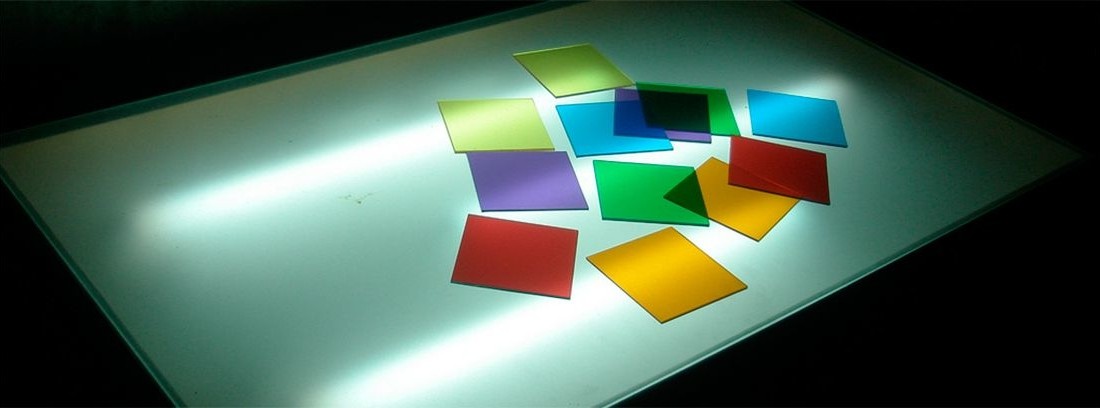Proper use of light tables for children

The tables of light are a powerful visual stimulus, it is advisable to know how to use it in the best possible way, since its main users are kids very small with a vision still in development.
What is a night table?
A nightstand is simply a table whose surface is illuminated. There is a wide variety of formats and qualities: portable plastic boxes or drawers, wooden tables with LED lights, even very thin portable screens. The bedside tables are beginning to be used as didactic and sensory resource from 18 months, although there are families or educational centers that can start earlier. It is based on the Reggio Emilia pedagogical approach. This early childhood pedagogy is based on the vision that every child is strong, capable and flexible, bearer of great potential and an innate curiosity that leads them to discover the world around them, building their own learning as long as they provide you with an enriched and appropriate environment. The name of Reggio Emilia is due to the fact that this pedagogy was developed in the Italian city with the same name.
Why is it such an interesting teaching resource?
Is a visual sensory stimulus fantastic, which allows the child to see beyond: more intense colors, transparencies, details when playing with translucent materials or working with silhouettes. The tables of light has a captivating and magical power by itself, any material, however simple it may seem, is transformed into something special and different, such as sand, semolina or transparent colored pieces. Children tend to concentrate and relax for long periods of time favoring free play. We can summarize the benefits of the light table in:
- Power curiosity and motivation to learn from "doing" and experimentation.
- Light and materials they favor concentration.
- Many aspects of learning can be worked in a very original way, from literacy, to mathematics, scientific activities or spatial orientation.
- Favors free play enhances creativity and imagination.
- The stimulation Sensory is very powerful, both visual and tactile. Promotes sensory integration.
- The activities that can be proposed provide a level of enjoyment and relaxation very interesting for the child.
However, not everything goes and not every bedside table is recommended for working with children. Quality is very important and must meet some minimum security to protect the child's vision. First of all, the light must be adequate and distributed evenly, avoiding dark spots or areas and areas of greater intensity from being seen in another part of the work surface. Different intensities can damage your child's vision.
Are LED lights safe?
Regarding the use of LED lights, there has been a lot of controversy about their health effects. A study carried out in Spain has confirmed that the main problem with these LED lighting sources is that they emit white light, but with a high content of blue band radiation. This blue light is what can affect our retina. We must know that the retina is a sensitive tissue that never regenerates, that is, we are born and die with the same retina. The European Commission and its Scientific Committee on Health, Environment and Emerging Risks published in 2018 a document on the potential risks to human health of Light Emitting Diodes (LED). There appears to be no evidence of direct adverse health effects of LEDs in normal use (lighting and displays) by the healthy population. What it does notice is that children have a greater sensitivity to blue light. Blue LEDs (between 400nm and 500nm), including those in toys, can be very dazzling and can cause photochemical retinopathy in children under three years of age. The eyes of the children are more sensitive to light because they allow more of it to pass through than adults.
Light, melatonin and sleep
Use the Light table at night it is not the best option. The use of screens at night reduces the production of melatonin, the hormone that regulates the sleep-wake cycle. This decrease can cause sleep and metabolism disturbances. Adolescents and children are very sensitive to light exposure. At the University of Colorado, a study of light exposure was conducted in young children before going to sleep. During the game with light tables there was a reduction of almost 90% and the effects lasted when the exposure to light ended. Fifty minutes after the lights went out, most children did not reach 50% of normal melatonin levels. As a conclusion to these results, it is worth do not expose children to screens one hour before going to sleep.
Screen abuse issues
In summary, those derived from an abusive use of screens or work with direct light, such as bedside tables, can develop:
- Dry Eye: This is due to the fact that very high levels of attention are generated that decrease the frequency of blinking, drying the eye.
- Sleeping problems: blue light decreases the production of melatonin, so it can disturb your sleep.
- Eye accommodation problems: Spending a long time focusing closely can cause blurred vision when you want to focus on more distant objects, and cause functional myopia.
- Not everything goes and not every bedside table is recommended for working with children. The quality is very important and must meet minimum safety standards to protect the child's vision.
- The light must be adequate and distributed evenly uniform, avoiding that dark spots or areas and areas of greater intensity are seen in another part of the work surface.
- Children have a greater sensitivity to blue light. Blue LEDs (between 400 and 500 nm), including those from toys, can be very dazzling and cause photochemical retinopathy in children under three years of age.
Pediatric specialist Advance Medical Consultant Physician
(Updated at Apr 15 / 2024)